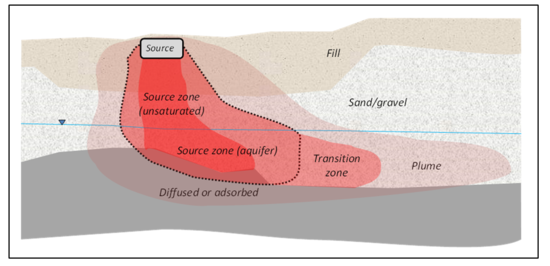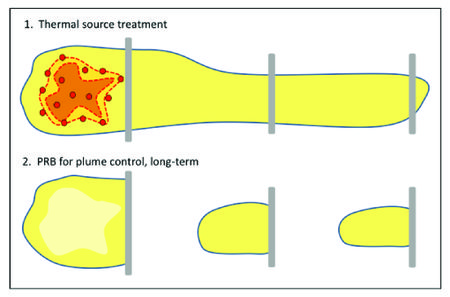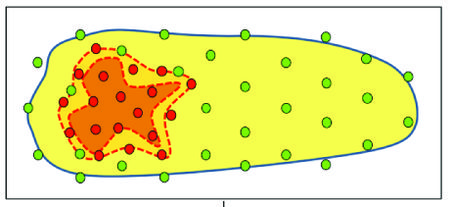Thermal Remediation - Combined Remedies
Complex sites often require a combination of technologies for complete remediation. At heavily contaminated sites, in situ thermal treatment may be used to treat the source, while other technologies are used in the transition and plume zones. The three major in situ thermal remediation (ISTR) technologies are Steam Enhanced Extraction (SEE), Electrical Resistance Heating (ERH), and Thermal Conduction Heating (TCH). These technologies can be combined with in situ chemical oxidation, in situ chemical reduction, bioremediation, permeable reactive barriers, and monitored natural attenuation to provide complete site solutions. They may be enhanced using hydraulic or pneumatic fracturing and emplacement of permeable materials.
Related Article(s):
- Thermal Remediation
- Steam Enhanced Extraction (SEE)
- Electrical Resistance Heating (ERH)
- Thermal Conduction Heating (TCH)
CONTRIBUTOR(S): Dr. Gorm Heron
Key Resource(s):
Introduction
Most complex sites can be divided into three zones (Figure 1):
- A source zone where higher concentrations exist – typically in the form of non-aqueous phase liquids (NAPLs) or strongly sorbed contaminants. Note that source zones often have a component above the water table (in the vadose zone) and below the water table (in the aquifer).
- A transition zone where some NAPL may exist in small stringers, ganglia or droplets, but where the mass is smaller and concentrations lower. In some instances this is referred to as a dilute source or the plume core.
- A dissolved plume where contaminants of concern (COCs) exist in dissolved or adsorbed phases. Often, the plume is affected by lower permeability layers, where the COCs have diffused in over time and can become a long-term source as the chemicals diffuse back out because concentration gradients are reversed during remediation.
| Zone | Characteristics | Technologies |
|---|---|---|
| Source | Large mass, NAPL or strongly adsorbed contaminants. Both vadose zone and aquifer contamination |
Thermal (high mass, stringent criteria), ISCO (lower mass), EZVI (modest mass) Soil Vapor extraction used in vadose zone |
| Transition | Intermediate concentrations, modest mass, typically below the water table |
ISCO, ISCR, EZVI, thermal if stringent criteria must be met quickly |
| Plume | Dissolved or adsorbed contamination | Bioremediation, permeable reactivebarriers (PRBs), monitored natural attenuation (MNA) |
For successful remediation, it is crucial that every site is well understood and that a good site conceptual model (CSM) is developed. A good CSM is the basis for selecting remedial technologies that are effective in each of the zones. In source zones, technologies must often be effective both above and below the water table. The specific physical characteristics of the contaminants of concern and of the soils must also be considered in selecting the optimal remedy[2]. Several commonly applied technologies for the three different zones are shown in Table 1.
These technologies must be combined based on site-specific characteristics, remedial objectives, and the capabilities of each technology. One example of a combined remedy is when thermal treatment is used to reduce the source concentration/mass, and a set of permeable reactive barriers are used to control and remediate the plume in the years following thermal treatment (Figure 2). Another example is thermal treatment of the source zone combined with bioremediation of the transition zone and dissolved plume (Figure 3).
Case Studies
Recent examples of combined remedies with a thermal component include:
- Endicott, NY: A PCE source zone was removed using Thermal Conduction Heating (TCH), reducing the source mass discharge by three orders of magnitude. Pump and treat and monitored natural attenuation were used for the plume. Five years after thermal treatment, the plume had shrunk enough that the pump and treat system was shut down[1].
- Memphis Depot, TN: Thermal treatment removed eight source zones from the upper 30 ft of a silty loess formation, while soil vapor extraction was used to remediate the less concentrated zones in between and below the source zones[3].
- Fort Lewis, WA: Thermal treatment of three source zones followed by low temperature and low energy ERH with in situ bioremediation in the transition and plume zones[4][5][6].
Summary
Thermal technologies can be coupled with less intensive solutions to provide integrated solutions for complex sites. By treating the source zones thermally, most of the chemical mass may be removed. This facilitates treating the transition zone and the plume effectively. Thermal treatment is most often combined with soil vapor extraction and enhanced bioremediation, but site-specific analyses must be used to determine the best options for each site.
References
- ^ 1.0 1.1 Heron, G., Bierschenk, J., Swift, R., Watson, R. and Kominek, M., 2016. Thermal DNAPL Source Zone Treatment Impact on a CVOC Plume. Groundwater Monitoring and Remediation, 36(1), pp. 26-37. doi: 10.1111/gwmr.12148
- ^ Davis, E.L., 1997. How Heat Can Accelerate In-situ Soil and Aquifer Remediation: Important Chemical Properties and Guidance on Choosing the Appropriate Technique. US EPA Ground Water Issue Paper EPA/540/S-97/502. Report.pdf
- ^ Heron, G., Parker, K., Galligan, J., and Holmes, T.C., 2009. Thermal Treatment of 8 CVOC Source Zones to Near Nondetect Concentrations. Groundwater Monitoring and Remediation, 29(3), pp. 56-65. DOI: 10.1111/j.1745-6592.2009.01247.x Open Access Article
- ^ Truex, M., Powell, T. and Lynch, K., 2007. In Situ Dechlorination of TCH during Aquifer Heating. Ground Water Monitoring and Remediation, 27(2), pp. 96-105. DOI: 10.1111/j.1745-6592.2007.00141.x
- ^ Powell, T., Smith, G., Sturza, J., Lynch, K. and Truex, M., 2007. New Advancements for In Situ Treatment Using Electrical Resistance Heating. Remediation Journal, 17(2), pp. 51-70. DOI: 10.1002/rem.20124 Free download from: California EPA.
- ^ Macbeth, T., Truex, M., Powell, T., Michalsen, M., 2012. Final Report: Combining Low-Energy Electrical Resistance Heating with Biotic and Abiotic Reactions for Treatment of Chlorinated Solvent DNAPL Source Areas, ESTCP Project ER-200719. Project Website Report.pdf


